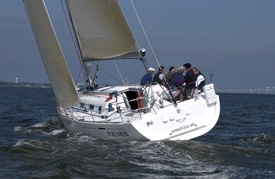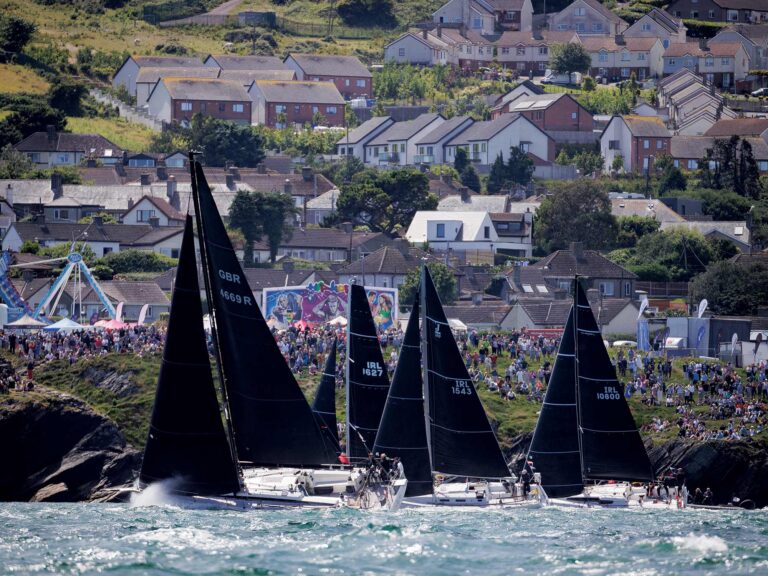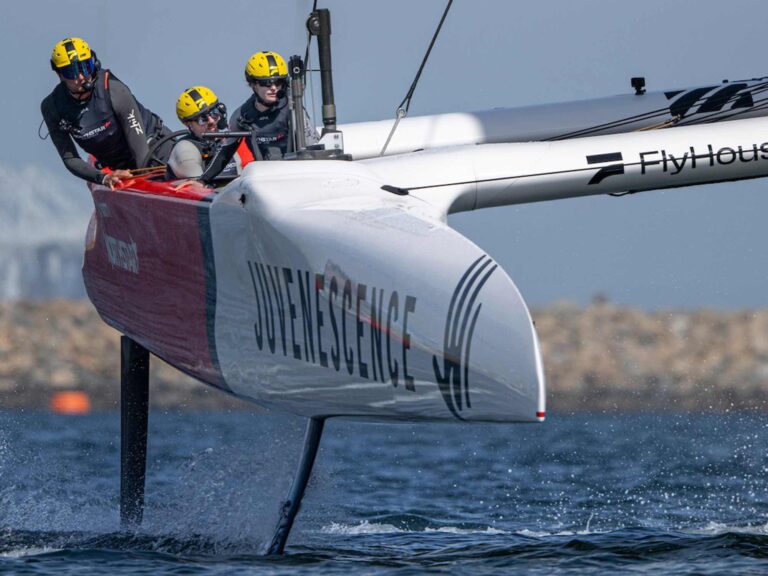
BOTY-Beneteau 44.7
Beneteau, one of the world’s biggest boatbuilders, and Farr Yacht Design, one of the world’s most successful racing design offices, make a formidable team. Their latest collaboration, the Beneteau First 44.7, is a prime example of what two such powerhouses can produce. Using feedback from owners of the First 40.7 and not bound in any way by the IMS rule, the 44.7 will speak to those who appreciate how well Beneteau can build a boat and Farr can design. Those who have sailed or owned a Beneteau will feel right at home on the First 44.7, as will those who have experience sailing Farr designs. The boat is comfortable to the point of opulence below, and the sailing qualities are exemplary. With three versions of the First 44.7 available (Standard, with a two-spreader aluminum rig and wire rigging; Race 1, a tapered rig with three spreaders and Dyform rigging, and Race 2; a three-spreader carbon rig with rod rigging), it should be no problem choosing the right setup for your needs. The 44.7 is, pound-for-pound, more powerful and stiffer than the 40.7 and provides plenty of grunt in all three configurations, even in the light stuff we sailed in off Annapolis. Unlike the 40.7, the 44.7 has an enclosed transom, but under the shaped helmsman’s seat is the well-thought-out stowage for liferafts. The large diameter Lewmar Y-spoke wheel is sunk into the deck and placed so that nearly every position the helmsman might use is accommodated. Surrounding the cockpit are aluminum Lewmar winches; the latest in lightweight technology. The mainsheet is led, grand-prix style, along the decks and back to the trimmer, whose position is close to both winches and helmsman. The traveler runs across the cockpit immediately forward of the wheel, in as unobtrusive a place as possible, and the sheet lead from the boom is exactly perpendicular to the traveler, something we didn’t see on all the boats we sailed. Any objections about buying a performance sailboat and sacrificing comfort will be laid to rest at first glance below. Thanks to the long, low deckhouse, there’s headroom aplenty, topping out at an impressive 6’9″ in the aft head and 6’8″ in the main cabin. Two staterooms sit port and starboard under the cockpit, and immediately forward of the port stateroom is a head, which is across from the L-shaped galley. The nav station is located to port at the center of the boat, across from a C-shaped couch/settee. The nav station couldn’t be in a better place for offshore racing; away from wind and water, close to the center of effort, and facing the only direction a nav station should face: forward. There’s plenty of room for nav displays and even a storage area with cubbyholes for books, signal flags, and binoculars. The use of light-colored wood throughout makes the interior of the 44.7 seem even larger than it is, and even if the weather is terrible outside, it’ll be no hardship to spend time down below. The majority of the keelbolts and the lowest part of the bilge are directly underneath a settee bench that faces the large dinette table and sits on centerline. Keelbolt and bilge inspections are easily done by lifting the lever-action seat and moving it to port. All fuel and water tanks are on centerline, and all bulkheads bonded 360 degrees to hull and deck for structural strength. An available option we thought was a great idea for some sailors was an empty forepeak, which will reduce weight in the bow and be ideal for sail stowage. It’s easy to tell that the 44.7 was designed with input from owners of previous Beneteaus; access to the engine was among the best we’ve ever seen. Two gas pistons lift the companionway stairs assembly and reveal an engine with a large shroud covering belts and other moving parts. The water pump faces forward, which allows for the impeller to be changed out without removing the entire unit. Access to all the engine filters is also excellent. The standard engine is a 40 hp. Volvo 2040 powering a sail drive unit; the optional engine is a 55 hp. Volvo D255. Engine noise below was negligible, which means that the off watch will be able to sleep even during battery-charging sessions. The 44.7’s hull is solid fiberglass with a laminated structural hull liner for load bearing and distribution. The deck is fiberglass sandwich with a balsa core and unidirectional weave. The overall quality of the wood and glasswork below is excellent, reflecting the experience of the boatbuilders in Beneteau’s assembly plant in France, where the 44.7 will be built exclusively. Meade Gougeon, our epoxy expert, was impressed that the ends of all wood floorboards and panels were sealed, which means they won’t absorb water, swell, and not fit where they belong. We sailed the 44.7 in a light but steady breeze with a total of six crew. In 8 knots of breeze, we sailed an easy 7.4 knots upwind with two-fingers on the wheel. The cockpit was easy to work in, with the pitman’s position especially well set up. The main has a large roach, and but a quick shake of the backstay gets the leech free if it gets hang up on the backstay. The solid vang is Navtec and its controls lead aft from the rig alongside the halyards and topping lift. The unobtrusive deckhouse provides a wide platform for crewwork, as does the wide bow. The molded nonskid throughout provides good traction. The only quibble we had was that the toe rail extends the length of the boat, but an available option is a toerail that’s 5/8″ lower. The 44.7 has a Chesapeake Bay PHRF rating of 44, and we have a feeling that-especially with the two-spreader aluminum rig-the boat will rate well in IRC as well.









